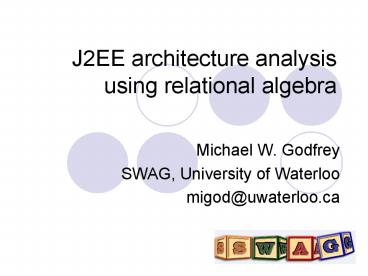J2EE architecture analysis using relational algebra PowerPoint PPT Presentation
Title: J2EE architecture analysis using relational algebra
1
J2EE architecture analysis using relational
algebra
- Michael W. Godfrey
- SWAG, University of Waterloo
- migod_at_uwaterloo.ca
2
From RAMP to SALSAA success story of
migrating research ideas into industry
- Michael W. Godfrey
- SWAG, University of Waterloo
- migod_at_uwaterloo.ca
3
Lossy program analysisorLies my extractor told
me
- Michael W. Godfrey
- SWAG, University of Waterloo
- migod_at_uwaterloo.ca
4
Research pre-history
- 2002 a research project called RAMP is born
- RAMP Rapid Assisted Migration Project
- An industrial research collaboration with Sun
Microsystems - Principal investigators
- UW Profs Holt / Malton / Godfrey
- Sun Brian Down, Wai-Ming Wong
- Part of the CSER research consortium
- http//www.cser.ca
5
RAMP goals
- Investigate aiding assisted software migration
- Quick dirty architecture modelling and analysis
- Building a KB of discovered problems
- Analysis of sw construction processes and
artifacts
6
RAMP to Jackpot
- Contacts thru Sun / RAMP / conferences led to a
sabbatical invitation - Sept-03 to Aug-04 in Suns Research Lab in
Mountain View, CA - Jackpot An AST-based analysis tool
- Team members
- Michael Van De Vanter, James Gosling, Tom Ball,
Tim Prinzing
7
Suns Jackpot Tool
- AST-based analysis transformation tool
- Metrics summaries
- Bad smell detection
- Semi-automated source transformation
- J-to-Java migration, bad smell removal,
- Code visualization
- Smart editor support
- Basic idea
- Suck up whole program into memory
- Play with the AST
- Output transformed source code
8
Jackpot
- When I arrived in Sept 2003
- Basic infrastructure works
- Several bad smells can be detected automatically
- Several automated transformations work
- ...
- But
- While the technology is very promising, its hard
for outsiders to pick up and adapt easily - Must understand both Jackpot and javac internals
- Work is slow going and very detailed (AST hacking)
9
Solve a Real Problem
- Van De Vanter introduces me to John Crupi, who
has a problem - We wrote the book on J2EE patterns (good and
bad), but were still using grep and perl to fix
them ! - I meet with Van De Vanter, Crupi, several times
to sketch out the design of a prototype J2EE
architecture analysis tool based around Jackpot
10
Lossy program analysis
Source code
Simplified prog lang schema
Lossy fact extractor
Program facts
Query engine
Canned design queries
Live queries
11
Kinds of program analysis tools
- Special purpose, batch static analysis tools
- Read in code, analyze, spit out (relatively
small) result set - Result set typically makes no sense on its own
need refs back to source code - Analysis goals hard-coded into tool
- New goals? Write a new tool!
12
Kinds of program analysis tools
- Whole earth / big bang analysis tools
- Perform generic analysis (e.g. compilation) and
keep all of compilation facts in store - Then allow AST walkers to generate desired info
- Source-to-source code transformation also
possible - Analysis results can be customized via new tree
walkers - Slow and detailed work
- but you can do just about anything to the
source code - Each run requires a new compilation (or reading
in saved AST / symbol table)
13
Kinds of program analysis tools
- Lossy program analysis
- Generates a set of facts about the program
- An abstracted (lossy) view of the system,
according to a defined schema - The facts are complete, relative to their defined
abstraction level - e.g., can spot global variable uses across
packages, but no information about how for loops
are used - Source code examined only once
- New run of the tool means only loading the
facts into the query engine - Can add / refine queries using same factbase
(since the facts dont change unless the code
does)
14
Lossy program analysis
- Advantages
- Much easier to write canned queries, GUIs for
navigation, experiment / go fishing with results - Model is self-contained, complete so no need to
consult or link back to source code - Source code examined only once!
- Loading factbase usually much faster than
compilation - Disadvantage
- Source-to-source code transformation not possible
- But can feed results back into a whole-earth
analsyis tool - e.g., find known bad smells, feed the fixes to a
transformation engine
15
(No Transcript)
16
Jackpot-to-SALSA
- I finish my extractor (still part of Jackpot),
and give a demo for Crupis group - I show how to define and run pattern queries they
specify (using grok/QL) on source code theyve
provided
// Want to find all SessionBeans that call
EntityBeans extendsRTC extends subtypeof
extendsRTC extendsRTC o implements o
extendsRTC sessionsBeanClasses classes
subtypeof . "javax.ejb.SessionBea
n" entityBeanClasses classes subtypeof .
"javax.ejb.EntityBean" sessionBeansCallingEntity
Beans sessionsBeanClasses o calls o
entityBeanClasses
17
SALSA goals Crupi
- Crupi pitches the idea to several big clients
- It is very enthusiastically received!
- The SALSA project (Sun Appliance for Live
Software Analysis) is born! - Main goal
- (Semi-) automate architectural assessment as much
as possible - Aim for remote, collaborative, client-driven,
early feedback - Ship with a library of known bad patterns
allow application/domain knowledge to be added - Feedback into the code (comments, annotations,
transformed source code)
18
Current Status
- I finished the fact extractor
- Now, a standalone Java 1.5 application
- If javac can compile your code, I can extract it!
- Extracts info about generic classes/methods,
inner (non-local) classes, exceptions,
initialization clauses, parameters, - Ongoing work at UWaterloo
- A co-op student who worked on Jackpot has been
working with me on extending this work will
start an MMath in Fall. - Recently completed byte-code extractor using
same schema - Next step characterizing NFRs (e.g., security
concerns) using the extracted facts - Work on SALSA continues at Sun
- Patterns library
- GUI
- Infrastructure enhancements

